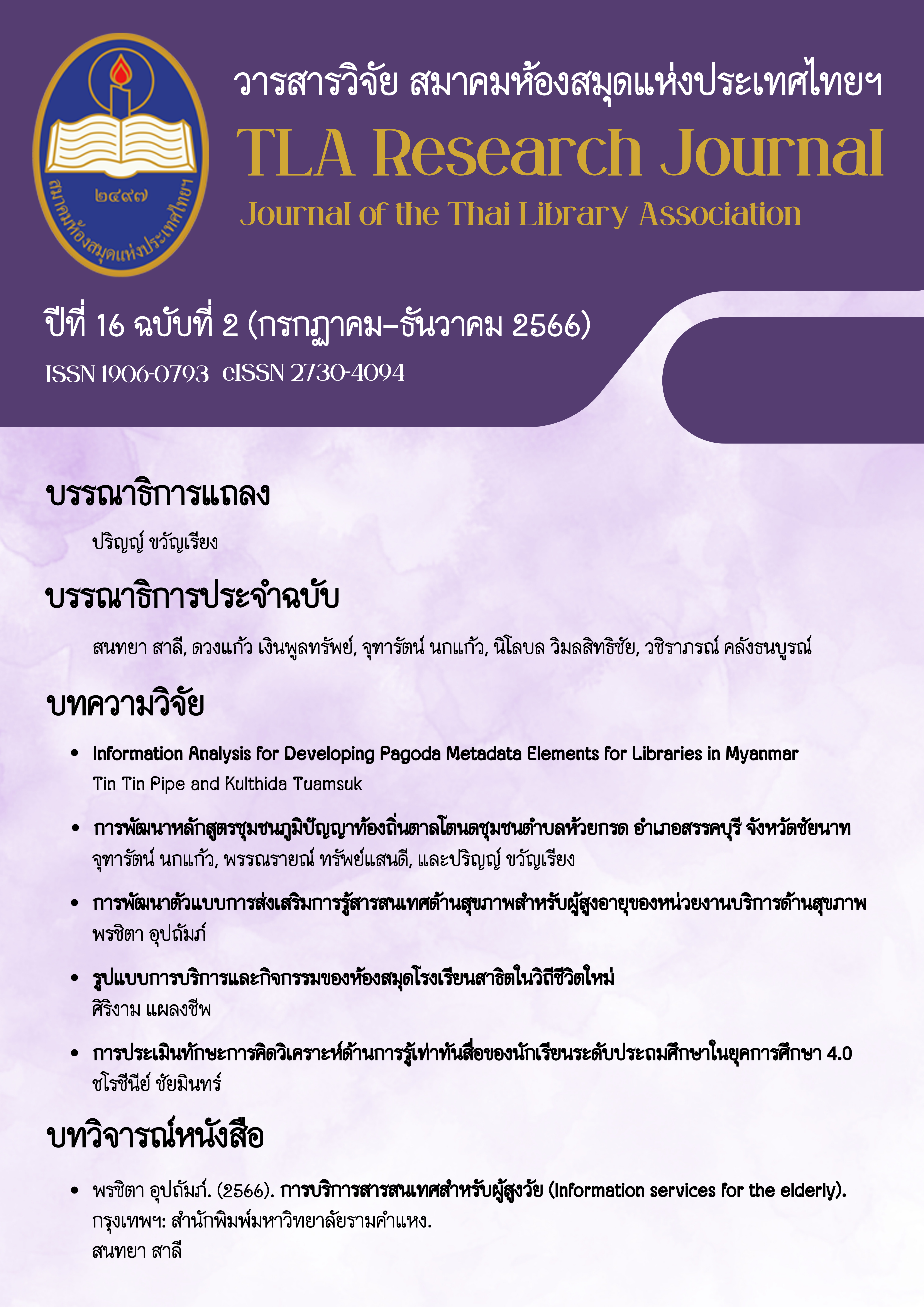การวิเคราะห์สารสนเทศเพื่อการพัฒนารายการข้อมูลเมทาดาตาเจดีย์สำหรับห้องสมุดในเมียนมาร์
Main Article Content
บทคัดย่อ
งานวิจัยนี้มีจุดมุ่งหมายเพื่อวิเคราะห์สารสนเทศที่เกี่ยวข้องกับการพัฒนาข้อมูลเมทาดาตาเจดีย์สำหรับห้องสมุดในประเทศเมียนมาร์ เป็นส่วนหนึ่งของการวิจัยเพื่อพัฒนามาตรฐานเมทาดาตาเพื่อการจัดการข้อมูลเจดีย์ในขั้นตอนต่อไป วิธีวิจัยใช้วิธีการเชิงคุณภาพ โดยการอ้างอิงข้อมูลจากผลการศึกษาความต้องการเมทาดาตาของบรรณารักษ์หอสมุดแห่งชาติและห้องสมุดมหาวิทยาลัยในประเทศพม่าที่ได้ดำเนินการไปก่อนแล้ว นำมาร่างแนวทางการพัฒนาเมทาดาตาตามกรอบแนวคิด Functional Requirement for Bibliographic Records หรือ FRBR Model การวิเคราะห์รายการข้อมูลที่ปรากฎในมาตรฐานเมทาดาตาที่เหมาะสำหรับการจัดการสารสนเทศทางวัฒนธรรม ได้แก่ Categories for the Description of Works of Arts (CDWA) และ Visual Resources Association (VRA Core) และแนวคิดการวิเคราะห์สารสนเทศเพื่อพัฒนาเมทาดาตาที่ประกอบด้วย เนื้อหา บริบท และโครงสร้าง ผลการวิเคราะห์สารสนเทศโดยเชื่อมโยงกับคุณลักษณะของเจดีย์ในเมียนมาร์และความต้องกา เมทาดาตาของบรรณารักษ์ ทำให้ได้รายละเอียดของข้อมูลที่จำเป็นในส่วนที่เป็นเนื้อหา บริบท และโครงสร้าง ซึ่งจะใช้เป็นฐานในการพัฒนามาตรฐานเมทาดาตาสำหรับการจัดการข้อมูลเจดีย์ในเมียนมาร์ต่อไป
Article Details

อนุญาตภายใต้เงื่อนไข Creative Commons Attribution-NonCommercial-NoDerivatives 4.0 International License.
บทความทุกเรื่องที่ลงตีพิมพ์จะได้รับการตรวจอ่านโดยผู้ทรงคุณวุฒิ ความคิดเห็นและบทความที่ปรากฏในวารสารนี้ เป็นของผู้เขียนซึ่งมิใช่เป็นความคิดเห็นของคณะผู้จัดทำ และมิใช่ความรับผิดชอบของสมาคมห้องสมุดแห่งประเทศไทยฯ การนำบทความในวารสารนี้ไปตีพิมพ์ซ้ำต้องได้รับอนุญาตจากคณะผู้จัดทำ
All articles submitted for publication will be reviewed by the academic reviewers. The editorial board and TLA claim no responsibility for the content or opinions expressed by the authors of individual articles or columns in this journal. Reprinting of any articles in this journal must be permitted by the editorial board.
เอกสารอ้างอิง
Baca, Murtha. (2008). Introduction to metadata (M. Baca, Ed.; 2nd ed.). Getty Research Institute. Retrieved from https://www.scribd.com/document/205239148/Introduction-to-metadata
Chamnongsri, N., Manmart, L., Wuwongse, V., & Jacob, E. K. (2006, January 1). Applying FRBR Model as a Conceptual Model in Development of Metadata for Digitized Thai Palm Leaf Manuscripts. Springer eBooks. https://doi.org/10.1007/11931584_28
Coyle, K. (2010). Chapter 3: FRBR, the Domain Model. Library Technology Reports. Retrieved from https://journals.ala.org/index.php/ltr/article/view/4676/5553
Eklund, J. (2007). VRA Core 4.0 Element Description. Retrieved from http://www.cl.cam.ac.uk/~mgk25/iso-time.html
Freire, N., Charles, V., & Isaac, A. (2018). Evaluation of Schema.org for Aggregation of Cultural Heritage Metadata. Retrieved from http://schema.org/docs/about.html
Gartner, R. (2003). MODS: Metadata Object Description Schema. Pearson New Media Librarian Oxford University Library Services, October.
Getty, J. P., & Artstor, T. (2006). CDWA Lite: Specification for an XML Schema for Contributing Records via the OAI Harvesting Protocol. Retrieved from http://www.getty.edu/research/conducting_research/standards/cdwa/cdwalite/cdwalite.pdf
Harpring, P. (Ed.). (2022). CDWA List of Categories and Definitions. Paul Getty Trust & College Art Association. Retrieved from www.getty.edu/research/publications/ electronic_publica tions/cdwa/index.html
Hu, X., Ng, J., Xia, S., & Fu, Y. K. Y. (2017). Evaluating metadata schema for murals and stone cave temples: Towards digitizing cultural heritage. Proceedings of the Association for Information Science and Technology, 54(1), 491-494. https://doi.org/10.1002/pra2.2017.14505401054
Kakali, C., Lourdi, I., Stasinopoulou, T., Bountouri, L., Papatheodorou, C., Doerr, M., & Gergatsoulis, M. (2007a). Integrating Dublin Core metadata for cultural heritage collections using ontologies. Proceedings of the International Conference on Dublin Core and Metadata Applications, May 2014, 128–139.
Knight, M. (2023). Fundamentals of Metadata Management. DATAVERSITY. Retrieved from https://www.dataversity.net/fundamentals-metadata-management/
Kupryte, R., & Myat Sann Nyein. (2018). The eLibrary Myanmar Project: Benefits and Impact on Myanmar’s Higher Education Libraries. Retrieved from https://www.eifl.net/system/files/resources/201805/transforming_libraries_in_myanmar.paper_.consalxvii.pdf
Library of Congress. (2022). Outline of Elements and Attributes in MODS Version 3.7. Retrieved from https://www.loc.gov/standards/mods/mods-outline.html
Library of Congress Standards. (2022). Metadata Object Description Schema: MODS. Retrieved from https://www.loc.gov/standards/mods/
Ministry of Religious Affairs and Culture. (2018). Shwedagon Pagoda on Singuttara Hill - UNESCO World Heritage Centre. UNESCO World Heritage Convention. Retrieved from https://whc.unesco.org/en/tentativelists/6367/
National Information Standards Organization (U.S.). (2001). The Dublin Core Metadata Element Set: An American National Standard. NISO Press. Retrieved from https://core.ac.uk/download/pdf/58953858.pdf
Nyein, M. S. (2016). Transforming libraries in Myanmar: The eLibrary Myanmar project. Insights: The UKSG Journal, 29(3), 266-272. https://doi.org/10.1629/UKSG.319/
Oo, M. (2014). National Library of Myanmar Annual Report for the 22nd Conference of Directors of National Libraries in Asia and Oceania. Retrieved from https://www.nlm.gov.mm
Oo, M. (2016). Treasures of the National Library of Myanmar. Symposium Program for Digitization and Conservation of Myanmar Old Manuscripts. Retrieved from https://meral.edu.mm/records/1913
Oo, M. (2018). Annual report of the National Library of Myanmar. Retrieved from https://www.ndl.go.jp/en/cdnlao/meetings/pdf/AR2018_Myanmar.pdf
Pipe, T. T., & Tuamsuk, K. (2023). Pagoda data management and metadata requirements for libraries in Myanmar. Journal of Information Science Theory and Practice, 11(3), 79-91.
Porter, C. (2005). Developing a successful metadata schema. JOURNAL OF DIGITAL ASSET MANAGEMENT, 1(4), 245-248.
Tochukwu, C., & Henrieta, U. (2015). Designing a Web Based Digital Library Management System for Institutions and Colleges. IJISET-International Journal of Innovative Science, Engineering & Technology, 2(3). Retrieved from http://www.ijiset.com
Ronzino, P., Hermon, S., & Niccolucci, F. (2014). A Metadata Schema for Cultural Heritage Documentation. Eva Florence. Retrieved from https://www.researchgate.net/ publication/259786414
Shiri, A., & Villanueva, E. (2020,). Methodological Diversity in the Evaluation of Cultural Heritage Digital Libraries and Archives: Approaches, Frameworks, and Methods. Proceedings of the Annual Conference of CAIS/Actes Du Congrès Annuel de l ACSI. https://doi.org/10.29173/cais1177
Sugimoto, S., Baker, T., & Weibel, S. L. (2002). Dublin core: Process and principles. Lecture Notes in Computer Science (Including Subseries Lecture Notes in Artificial Intelligence and Lecture Notes in Bioinformatics), 2555, 25-35. https://doi.org/10.1007/3-540-36227-4_3
Sutton, S. A., & Mason, J. (2001). The Dublin Core and Metadata for Educational Resources. In Proceedings of the International Conference on Dublin Core and Metadata Applications 2001 (pp.25-31). Retrieved from https://doi.org/10.23106/dcmi.952106451
Techawut, C. (2010). Metadata Creation: Application for Thai Lanna Historical and Traditional Archives. In The Role of Digital Libraries in a Time of Global Change (pp. 144-147). Springer-Verlag Berlin Heidelberg.
Tillett, B. B. (2003). Functional Requirements for Bibliographic Records What is FRBR? A Conceptual Model for the Bibliographic Universe. Technicalities, 25(5). Retrieved from https://www.loc.gov/cds/downloads/FRBR.PDF
Turner, R. C., & Carlson, L. (2003). Indexes of Item-Objective Congruence for Multidimensional Items. International Journal of Testing, 3(2), 163-171. https://doi.org/10.1207/s15327574ijt0302_5
Wijesundara, C., & Sugimoto, S. (2018). Metadata Model for Organizing Digital Archives of Tangible and Intangible Cultural Heritage, and Linking Cultural Heritage Information in Digital Space. LIBRES, 28(2), 58–80. Retrieved from http://www.cidoc-crm.org/


